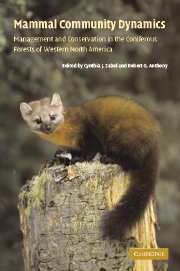 Mammal Community Dynamics
Mammal Community Dynamics Book contents
- Frontmatter
- Contents
- List of contributors
- Foreword
- Acknowledgments
- Part I Management and conservation issues for various taxa
- 1 Introduction and historical perspective
- 2 Forests and woodlands of western North America
- 3 Faunal composition and distribution of mammals in western coniferous forests
- 4 Habitat ecology and conservation of bats in western coniferous forests
- 5 Ecological relationships of terrestrial small mammals in western coniferous forests
- 6 Ecology and conservation of arboreal rodents of western coniferous forests
- 7 Small and mid-sized carnivores
- 8 Ecology, conservation, and restoration of large carnivores in western North America
- 9 Ungulates in western coniferous forests: habitat relationships, population dynamics, and ecosystem processes
- Part II Community and ecosystem relations
- Part III Conservation issues and strategies
- Index
- References
2 - Forests and woodlands of western North America
Published online by Cambridge University Press: 15 December 2009
- Frontmatter
- Contents
- List of contributors
- Foreword
- Acknowledgments
- Part I Management and conservation issues for various taxa
- 1 Introduction and historical perspective
- 2 Forests and woodlands of western North America
- 3 Faunal composition and distribution of mammals in western coniferous forests
- 4 Habitat ecology and conservation of bats in western coniferous forests
- 5 Ecological relationships of terrestrial small mammals in western coniferous forests
- 6 Ecology and conservation of arboreal rodents of western coniferous forests
- 7 Small and mid-sized carnivores
- 8 Ecology, conservation, and restoration of large carnivores in western North America
- 9 Ungulates in western coniferous forests: habitat relationships, population dynamics, and ecosystem processes
- Part II Community and ecosystem relations
- Part III Conservation issues and strategies
- Index
- References
Summary
Introduction
Forests and woodlands of western North America vary from massive redwood stands with lush herb and shrub understories to scattered juniper in near-desert environments; from pine and oak stands characteristic of semi-tropical Mexico to wind-blasted spruce on coastal headlands and isolated tree patches in Arctic tundra. Disturbance (including human activities), stand development, and succession create additional variation in each forest and woodland environment. Wildfire visits some environments infrequently, if ever, while others experience under-burns every 5–20 years. Boreal and moist coastal forests continuously blanket hundreds of thousands or millions of hectares while mountain tops in the Great Basin support a few hectares of trees kilometers from their nearest neighbors. Such tremendous forest variability provides habitat for a large number of mammal species. This chapter describes forests and woodlands, focusing on mature and older conditions, from the western edge of the Great Plains to the Pacific Ocean in Canada and the United States (Fig. 2.1). Discussion is organized using the geographic regions from Bailey (1995, 1998) aggregated to resemble ecological regions described by Barbour and Billings (2000). Readers interested in discussion of the causal environmental factors associated with plant community distribution should consult Bailey (1995, 1998) and Chabot and Mooney (1985).
For the purposes of this discussion, forests are composed of trees with crowns overlapping, generally producing ≥60% vertically projected canopy cover (Anderson et al. 1998). Closed forests generally have ≥75% canopy cover.
- Type
- Chapter
- Information
- Mammal Community DynamicsManagement and Conservation in the Coniferous Forests of Western North America, pp. 9 - 40Publisher: Cambridge University PressPrint publication year: 2003
References
- 3
- Cited by
